 |
New Zealand String Quartet
presented by Music Toronto |
| November 24, 2005 • Jane Mallet Theatre • Toronto |
|
|
A Flourish of Bows
by Stanley Fefferman |
The chair on which cellist Rolf Gjelsten’s sits is raised on a platform, but in every other respect, the NZQ is a feet-on-the-floor standup ensemble. Physically attractive, obviously fit, cheerful and flamboyant, they communicate the pleasure of making music. The sounds they feel at ease with include traditional Haydn and Beethoven structures as well as New Music explorations by Jack Body and John Psathas.
Psathas’ Abisheka is inspired by the buddhist notion of becoming like a vessel into which healing water can be poured. Accordingly, the composition is spacious and fluid, but the sounds this quartet generates are surprising to hear coming out of an ensemble of traditional strings: Chinese bells, Tibetan horns and finger cymbals, unnamable drones and a boneless flow of tones and quartertones of differing durations and textures, usually quiet, but sometimes passionate, loud, and forceful. The novelty of this music, so challenging to produce and so appealing to hear, disarms further criticism of the piece or the performance. The audience was captivated, to judge by the cheery faces and the applause.
We were brought to Haydn’s Quartet in D, Op.76, No. 5 with our taste for adventure whetted. This work is the first of the rich, orchestral string quartets Haydn wrote for London public audiences late in his life. The NZQ perked out of the contemplative mood of the previous piece and played Haydn’s melodies with a dynamic energy that seemed quite fierce at times. In the slow movement that brought back the contemplative mood, Helen Pohl’s first violin was notably clear and direct, in concerted harmony with the deeply felt lines of the cello. The “Finale” was treated humorously, like a keystone cops car chase sequence that the Quartet brought to climax and close with a sabrelike overhead flourish of their bows.
|
| Jack Body’s Three Transcriptions (1987) is based on the sounds of instruments heretofore strange to Western chamber music, namely: the Chinese ‘Yi’- a three-bladed Jews harp, and the ‘vahila’, a longitudinal, 18-metal-stringed bamboo tube zither. The music is written for a narrow range of notes repeated frequently. It manages to sound like a creaky Appalachian hoedown with a bouncy beat and a weird whistling rhythm, like a banjo, like a balalaika, like a flute, like a tabla, like a ukulele. The piece ended with a wild vocal‘yoop’ and the bass drum beat of stomping feet. |
|
 |
|
|
Beethoven’s monumental String Quartet in A minor, Op. 132, is Beethoven at his most mature, where he hymns out melancholy and deep reverence after his recovery from a serious illness. The NZQ’s approach was full of fire but relaxed, their pleasure with each other was palpable. The feeling at the waltz-like finale was joyful, as if the audience were the passengers and they were the crew that had piloted a giant airbus to a safe landing.
|
|
|
|
|
|
|


